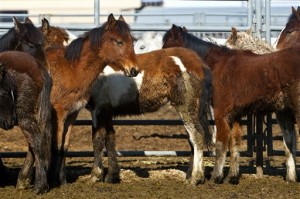Mustangs, once symbols of America’s Manifest Destiny, are now being seen more as a plague.
Thirteen southwestern and central Utah farmers have filed a lawsuit in the U.S. District Court in Salt Lake City against the Bureau of Land Management, claiming the agency is violating federal law. The suit says the BLM has failed to comply with the regulations set in the Wild Horses and Burros Act of 1971. The act protects wild horses “from capture, branding, harassment or death.”

“We believe they are flat-out breaking the law,” said Iron County Commissioner David Miller. “It is simple: the BLM has not managed the population appropriately, and it is affecting the livelihood, safety and welfare of the people here.” Iron County voted May 13 to join the lawsuit.
Since the BLM is forbidden by law to euthanize horses (the least expensive option) and because the BLM managers said last year that it did not have sufficient funds to do roundups this year, the Salt Lake Tribune reported. The overpopulation of the horses has led to overgrazing on not only public but on private rangelands, making food and water more scarce for the farmers’ livestock.
The ecosystem is too small to maintain the population of 14,000 wild horses, according to a BLM environmental assessment.
For the farmers of Beaver and Iron counties, some solace can be found with the environmental assessment. The report not only admits to a current overpopulation but states that wild horses are capable of increasing by 15–20 percent annually, resulting in the doubling of wild horse populations about every three years. In brief it states that if nothing is done the vegetation, the livestock, the indigenous wildlife, the vegetation and the horses themselves will be negatively impacted.
The assessment, which can be found on the BLM website, also presents multiple ways of trimming down the population. Among the methods allowed by the law, the cheapest is birth control. The expense with this method revolves around the capture and temporary holding of the horses. Another strategy would involve adoption after the capture.
“Fertility control has not yet proven to be successful,” said Brent Tanner, executive vice president of the Utah Cattlemen’s Association. “On top of that it could take 15 to 20 years to reduce the horses to a manageable number.”
In the meantime, no timetable has been set to act on any of the possible plans to reduce the population. Because in the report one of the proposed methods was reducing livestock rather than horses, the Iron County Commission says it is considering joining a similar lawsuit with surrounding counties complaining similarly.
The Utah Cattlemen’s Association, in a public statement, said it is “opposed to the removal or reduction of livestock from rangelands as an option or tool to mitigate impacts” and supported farmers’ livelihood.




